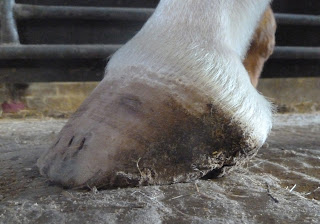I had a brilliant email yesterday, from Steve Leigh who is a barefoot bod from way up in the north east. He'd seen the
Rockley Scholarship post and liked it, but he's gone one step further. He's made a very generous offer to contribute £50 towards the transport costs for the horse who comes here on the scholarship.
Its a fabulous addition to the scholarship and may well make the difference between someone being able to bring their horse here or not (for those of you in the US, our petrol and diesel costs are running at about £1.40 per litre or more, so travelling horses round the country is becoming a VERY expensive business). I had to do a bit of persuading before Steve would let me thank him publicly and announce his offer on the blog, but it had to be done - THANKS STEVE :-)
ETA: I've just received another email from a long time supporter of the blog, Dawn Perkins, who has added another £25 to the transport pot - THANK YOU!
Thanks also to everyone who has helped spread the news of the scholarship. It looks as if nearly 1,000 people have read that post, so far, and I've now made it a permanent page on the blog:
http://rockleyfarm.blogspot.com/p/rockley-scholarship-2012.html just in case there is anyone who missed it first time round.
Its also time for updates on Georgia and Bryan, who have both been here for 2 weeks. Ladies first (and Georgia is definitely a lady!)....
As you know, she arrived in wedges and was pretty uncomfortable in them.
You have to excuse the fact that this update photo was taken in bad light but already you can see the change in her digital cushion which is much less crushed, more evenly loaded and beginning to develop.
You couldn't really see much of her sole at all in her wedges and pads but when I spoke to her vet he described her as having flat feet, collapsed heels and long toes. On MRI she also has DDFT damage and fibrocartilage erosion.
Out of shoes her feet are pretty weak and definitely flat, but with a good frog and certainly more than enough to work with.
The most interesting thing about this photo is the orientation of the frog - a sign that the hoof is starting to shift medially and load more centrally.
The long hoof wall has already mostly gone but there is no point whacking it off with a rasp and nippers - at the moment its allowing her a more gentle transition from peripheral loading to central loading.
Here is her footage. She had an exaggerated landing in shoes but has a reasonable landing out of shoes, though I will expect that to improve a whole lot more over the next few weeks.
Bryan is undoubtedly one of the kindest horses you could hope to meet and despite having only one eye he has done a great job of learning the Rockley landscape. He is now best buddies with Buster, who arrived last week, and if you didn't know that they had only just met you would swear they had been pals for years!
His worst foot was his LF which has only just started changing, of course, but you can see that the overly long hoof wall at his quarters is chipping away and his underrun heel is hinting at improvement. I would expect him to grow a hoof capsule at a much steeper angle but that won't be visible for another few weeks. a
Bryan's foot doesn't look too bad in the top photo but his heels are further forward than they should be and the widest part of his foot is also too far forward - some of it is long hoof wall but he has also not been loading his foot caudally but landing toe first instead, as you can see on the footage below.
Only a couple of weeks later and the widest part of the foot - and his heels - are shifting more towards the caudal hoof. Although (like Georgia) he is not yet landing as well as he will be, his landing is also starting to get better.


























































